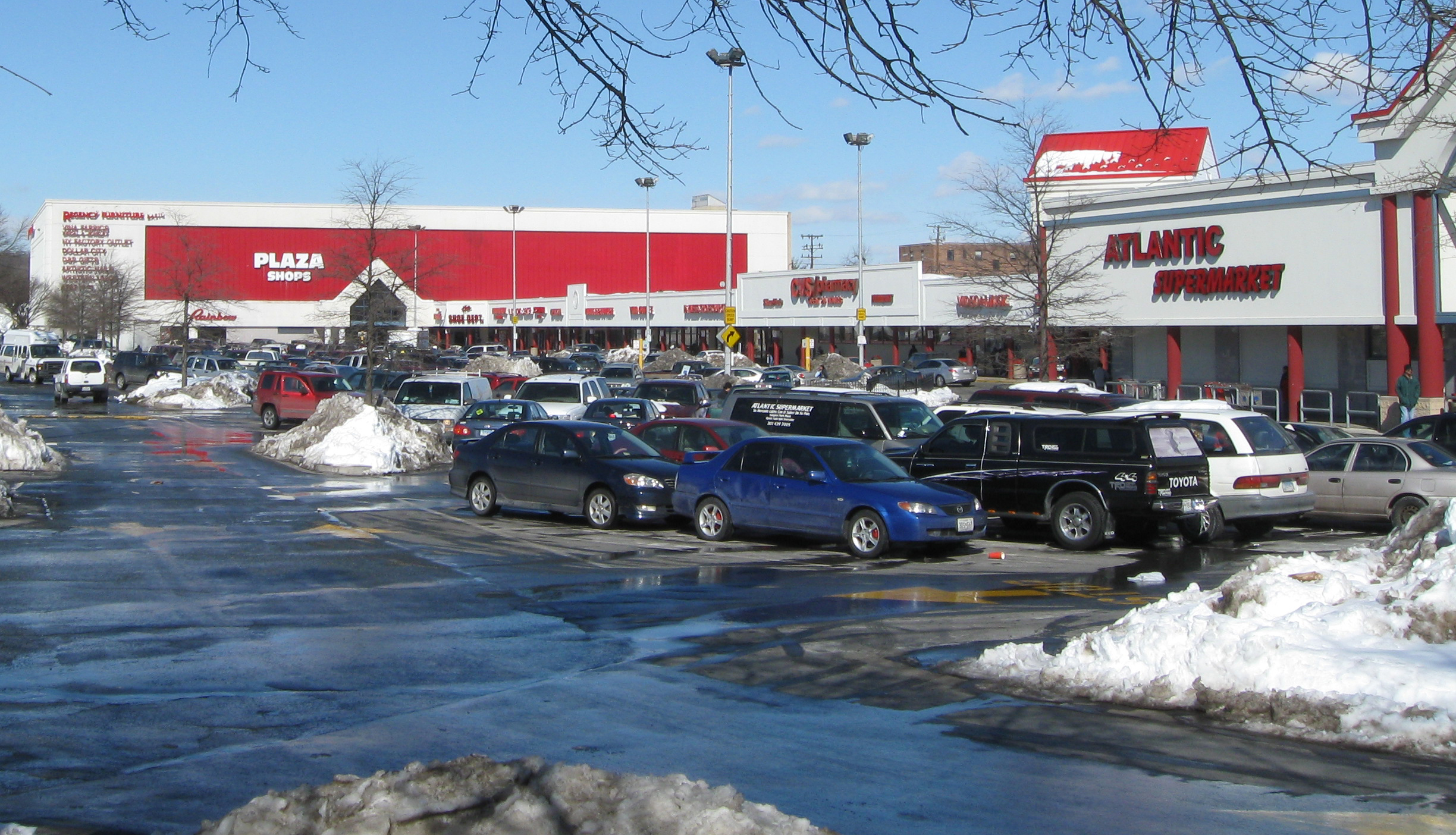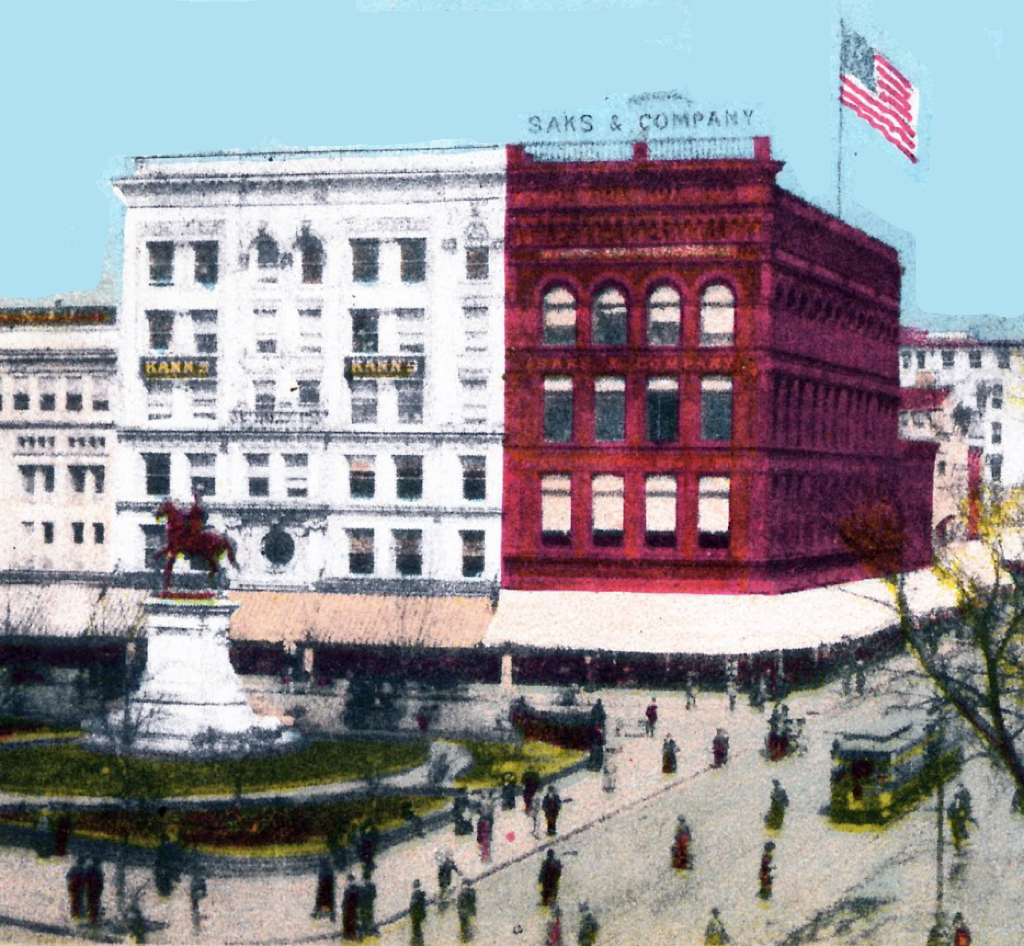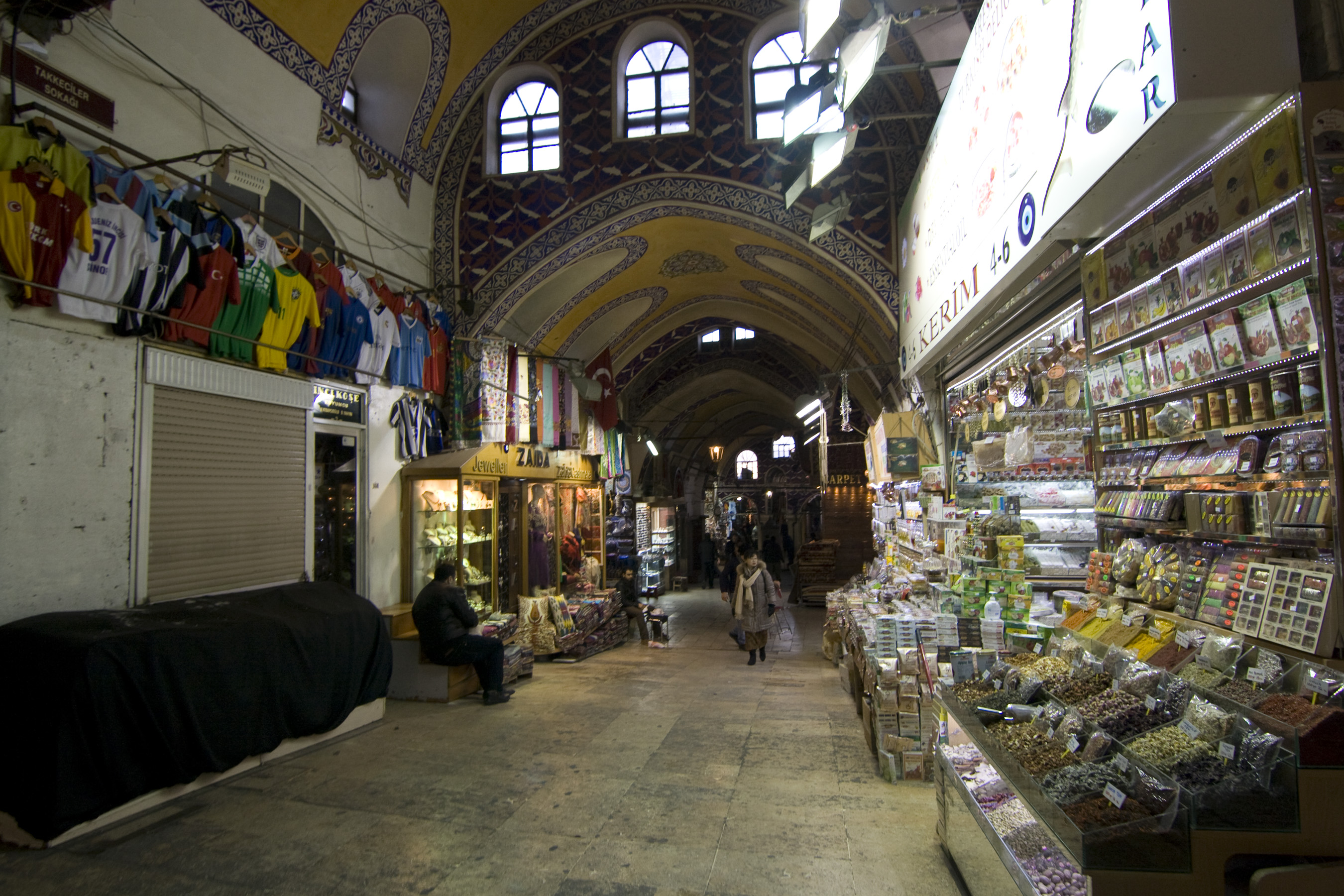|
Lansburgh's
Lansburgh's was a chain of department stores located in the Washington, D.C. area. The clientele were middle-income consumers. History The first store, at 7th and E Streets, NW, in Washington, D.C.'s downtown shopping district, opened on October 30, 1860. The founders were James and Gustav Lansburgh. The company was known initially for supplying the black crepe used for the funeral of President Abraham Lincoln. Lansburgh's installed the first elevator (wooden) in a commercial building in the District of Columbia. The company remained family owned until its acquisition by City Stores, Inc. in 1951. At the time of its final liquidation in June 1973, the chain ranked eighth in the Washington D.C. retail market, with sales of $28.5 million. Flagship store The initial Seventh Street flagship downtown store was located on and constructed in 1882, and was a work of architect Adolf Cluss. The store was greatly expanded in 1916, 1924 and 1941 out to Eighth Street. During the 1970 ... [...More Info...] [...Related Items...] OR: [Wikipedia] [Google] [Baidu] |
Langley Park, Maryland
Langley Park is an unincorporated area and census-designated place (CDP) in Prince George's County, Maryland, United States. It is located inside the Capital Beltway, on the northwest edge of Prince George's County, bordering Montgomery County. Per the 2020 census, the population was 20,126. History "Langley Park" refers to the Langley Park estate established in 1923 by the McCormick-Goodhart family in the Chillum District of Prince George's County. The name McCormick-Goodhart represented the linking of one of Chicago's oldest families, that of Cyrus McCormick, with that of British barrister Frederick E. McCormick-Goodhart. Frederick's wife Henrietta (Nettie) was the daughter of Leander J. McCormick, a brother of Cyrus. They named the estate "Langley Park" after the Goodharts' ancestral home in Kent, England. In 1924, they erected an , 28-room Georgian Revival mansion, designed by architect George Oakley Totten, Jr., at a cost of $100,000. It remains a community landma ... [...More Info...] [...Related Items...] OR: [Wikipedia] [Google] [Baidu] |
Adolf Cluss
Adolf Ludwig Cluss (July 14, 1825 – July 24, 1905) also known as Adolph Cluss was a German-born American immigrant who became one of the most important, influential and prolific architects in Washington, D.C., in the late 19th century, responsible for the design of numerous schools and other notable public buildings in the capital. Today, several of his buildings are still standing. He was also a City Engineer and a Building Inspector for the Board of Public Works. Red brick was Cluss' favorite building material; that, and his early communist sympathies, led some to dub him the "Red Architect", though he was a man who in later life became a confirmed Republican. Life He was born on July 24, 1825, in Heilbronn in the Kingdom of Württemberg in Southwest Germany. He was the fifth child of Johann Heinrich Abraham Cluss (1792–1857) and Anna Christine Neuz (1796–1827). His father was a master builder, and young Cluss set out as an itinerant carpenter when he left Heilbronn at ... [...More Info...] [...Related Items...] OR: [Wikipedia] [Google] [Baidu] |
F Street Shopping District
Parts of F Street and 7th Street, N.W. and nearby blocks have historically been the heart of the Washington, D.C. downtown shopping district. In the first half of the 20th century there were numerous upscale large department stores along and near F Street, while 7th Street housed more economical emporia and large retail furniture stores. The F street corridor stretches west from Downtown's Penn Quarter and Gallery Place towards 15th Street while the 7th Street corridor includes Penn Quarter, Chinatown and Mount Vernon Square neighborhoods and extends up to the border of Shaw. History Center Market, the city's largest public market, opened in 1872 operating until 1931 on the site of today's National Archives Building. Its northern end faced Pennsylvania Avenue between 7th and 9th street. Transportation by Washington, D.C.'s streetcars, first horse-drawn, then electrified, notably the busy transfer point at F and 9th, helped solidify this area as D.C.'s most popular shopping d ... [...More Info...] [...Related Items...] OR: [Wikipedia] [Google] [Baidu] |
Penn Quarter
Penn Quarter is a neighborhood east of Downtown Washington, D.C. and north of Pennsylvania Avenue, NW. Penn Quarter is roughly equivalent to the city's early downtown core near Pennsylvania Avenue and 7th Street NW, The definition of Downtown Washington has expanded to include areas further to the west, such as the Golden Triangle, southern Dupont Circle and West End areas. Penn Quarter has undergone urban renewal over the past several decades, first under the aegis of the Pennsylvania Avenue Development Corporation (PADC) and later, following the recession in the 1990s, by the addition of the MCI Center, now named the Capital One Arena, a sports, concert and event arena that opened at 7th and F streets in 1997. Penn Quarter contains many entertainment and commercial facilities such as museums, theaters, cinemas, restaurants, bars, contemporary art galleries and retail shops. The area is also home to a popular farmers market and several food, wine, art, and culture focused fe ... [...More Info...] [...Related Items...] OR: [Wikipedia] [Google] [Baidu] |
Tysons Corner Center
Tysons Corner Center is a shopping mall in the unincorporated area of Tysons in Fairfax County, Virginia, United States (between McLean and Vienna, Virginia). It opened to the public in 1968, becoming one of the first fully enclosed, climate-controlled shopping malls in the Washington metropolitan area. The mall's three department store anchors are Bloomingdale's, Macy's, and Nordstrom. Tysons Corner Center is the largest mall in the Baltimore-Washington area, and the 22nd largest in the United States. The mall is located from the central business district of Washington D.C., and neighbors a second mall, Tysons Galleria, across Chain Bridge Road. To distinguish the two, some people refer to Tysons Corner Center as "Tysons I," and Tysons Galleria as "Tysons II." History Tysons Corner Center was one of the first super-regional malls in the country, drawing customers from a multi-state area. The mall was built as a follow-on partnership by Isadore Gudelsky and Theodore Lerner' ... [...More Info...] [...Related Items...] OR: [Wikipedia] [Google] [Baidu] |
Shirlington Shopping Center
The Village at Shirlington opened as Shirlington Shopping Center in 1944, and was the first large shopping center to open in the Washington, D.C. suburbs and one of the earliest in the United States. It is located along Campbell Avenue (formerly South 28th Street) at the intersection of Shirley Highway and Quaker Lane / Shirlington Road in Arlington, Virginia. The center has been known since the mid-1980s as The Village at Shirlington. History The center was originally developed by Joseph Cherner, automobile dealer and banker, on a 23-acre site to provide for the basic shopping needs of the nearby sprawling Parkfairfax, developed by the Metropolitan Life Insurance Company, and the Defense Homes Corporation development at Fairlington. He established the Shirlington Corporation in August 1943, and the first store opened in June 1944. The center expanded gradually, with an increasing variety of retail offerings. In 1947, the local women's clothing chain Jelleff's chain opened a ... [...More Info...] [...Related Items...] OR: [Wikipedia] [Google] [Baidu] |
CSS Industries
CSS Industries, Inc., was founded in 1923, as City Stores Company. Its headquarters is at 1845 Walnut Street, Philadelphia, Pennsylvania, with showrooms in New York City, Memphis, Tennessee, Minneapolis, Minnesota, and Hong Kong. The company designs, manufactures, and distributes seasonal and everyday greeting cards and novelties. City Stores Company, 1923–1985 City Stores was a holding company, incorporated in the state of Delaware, that owned directly or indirectly all or a substantial majority of the stocks of several department and specialty stores in six states. It eventually controlled 39 stores in 19 states. The stores were serviced by a New York resident buying corporation, City Stores Mercantile Company, Inc., a subsidiary wholly owned by City Stores. In the 1950s, City Stores merged with Specialty Stores Co becoming City Specialty Stores. City Stores started in 1923 with the acquisition of three department stores: B. Lowenstein, Inc., of Memphis, Tennessee; Maison ... [...More Info...] [...Related Items...] OR: [Wikipedia] [Google] [Baidu] |
Rockville Mall
Rockville Town Center is a town centre in Rockville, Maryland. Opened in 1995, it replaced the recently demolished Rockville Mall.. History In 1962, Rockville became the first small city in Maryland to undertake a federal urban renewal program. Forty-six acres in the town center were bought; old and new buildings were demolished, and street patterns were changed. In their place rose the residential Americana Centre, more county buildings, high-rise offices, and a large shopping mall with 1,560 spaces of underground parking. A decade after the project began, the , 40 shop Rockville Mall opened in 1972, on . Although designed originally to have Sears and JC Penney as the two anchors, no second lease was ever signed. The sole anchor at opening was a branch of the Washington, D.C.-based Lansburgh's department store chain. Within a year, Lansburgh's closed and was replaced briefly with a branch of Lit Brothers, followed by a W. & J. Sloane furniture clearance center and Franklin ... [...More Info...] [...Related Items...] OR: [Wikipedia] [Google] [Baidu] |
Springfield Mall (Virginia)
Springfield Town Center is an enclosed shopping center located in the Springfield census-designated place (CDP) of unincorporated Fairfax County, Virginia. It opened in 1973 as Springfield Mall, an enclosed shopping mall, which closed on June 30, 2012 as part of a multimillion-dollar redevelopment plan to turn it into a multifaceted "Town Center"-style shopping center with a main indoor area similar to the nearby Tysons Corner Center and Dulles Town Center, while transforming the exterior into a pedestrian friendly environment with restaurants with cafe style outdoor seating and entrances. It is located at the intersection of Interstate 95 and Franconia Road (Route 644), which is part of the Springfield Interchange, 1/4 mile north of Franconia-Springfield Parkway (State Route 289) and the Franconia-Springfield Metro station. The mall reopened on October 17, 2014 following its two-year renovation. Original anchors were Lansburgh's (later E.J. Korvette), Garfinckel's (later Sp ... [...More Info...] [...Related Items...] OR: [Wikipedia] [Google] [Baidu] |
Lansburgh Flagship
Lansburgh may refer to: *G. Albert Lansburgh (1876–1969), American architect, known for his work on luxury cinemas and theatres * Richard H. Lansburgh (1893–1942), American economist, management consultant, Professor of Industry at the University of Pennsylvania's Wharton School *Lansburgh Theatre in downtown Washington, D.C. *Lansburgh's Lansburgh's was a chain of department stores located in the Washington, D.C. area. The clientele were middle-income consumers. History The first store, at 7th and E Streets, NW, in Washington, D.C.'s downtown shopping district, opened on Octobe ..., a chain of department stores in the Washington, D.C. area See also * Flansburgh (surname) * {{disambiguation, surname ... [...More Info...] [...Related Items...] OR: [Wikipedia] [Google] [Baidu] |
Retail Companies Disestablished In 1973
Retail is the sale of goods and services to consumers, in contrast to wholesaling, which is sale to business or institutional customers. A retailer purchases goods in large quantities from manufacturers, directly or through a wholesaler, and then sells in smaller quantities to consumers for a profit. Retailers are the final link in the supply chain from producers to consumers. Retail markets and shops have a very ancient history, dating back to antiquity. Some of the earliest retailers were itinerant peddlers. Over the centuries, retail shops were transformed from little more than "rude booths" to the sophisticated shopping malls of the modern era. In the digital age, an increasing number of retailers are seeking to reach broader markets by selling through multiple channels, including both bricks and mortar and online retailing. Digital technologies are also affecting the way that consumers pay for goods and services. Retailing support services may also include the provision of ... [...More Info...] [...Related Items...] OR: [Wikipedia] [Google] [Baidu] |
Retail Companies Established In 1860
Retail is the sale of goods and services to consumers, in contrast to wholesaling, which is sale to business or institutional customers. A retailer purchases goods in large quantities from manufacturers, directly or through a wholesaler, and then sells in smaller quantities to consumers for a profit. Retailers are the final link in the supply chain from producers to consumers. Retail markets and shops have a very ancient history, dating back to antiquity. Some of the earliest retailers were itinerant peddlers. Over the centuries, retail shops were transformed from little more than "rude booths" to the sophisticated shopping malls of the modern era. In the digital age, an increasing number of retailers are seeking to reach broader markets by selling through multiple channels, including both bricks and mortar and online retailing. Digital technologies are also affecting the way that consumers pay for goods and services. Retailing support services may also include the provision of ... [...More Info...] [...Related Items...] OR: [Wikipedia] [Google] [Baidu] |








